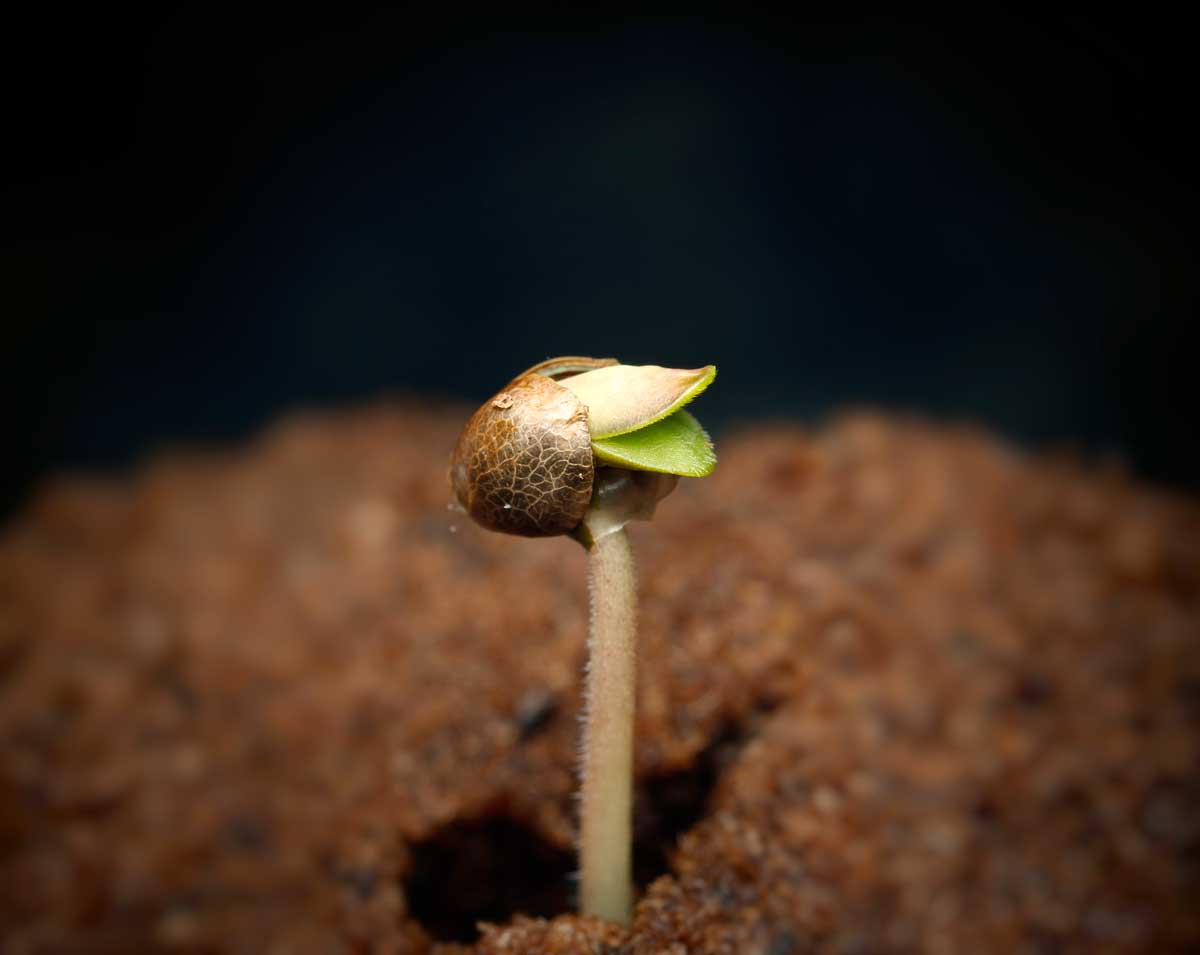She’s Got Legs! What You Can Do About Leggy Seedlings

It’s that time of the year and cannabis seeds are being started all over our wonderful state.
 It all starts when water meets the seed coat and germination begins. In a couple of days the cotyledon emerges from soil and the plant begins to grow towards the light.
It all starts when water meets the seed coat and germination begins. In a couple of days the cotyledon emerges from soil and the plant begins to grow towards the light.
The cotyledon are those two round leaves that first appear on top of the stalk. At this point the stalk is this thin stick of fleshy plant material. It’s quite delicate, green and grey in color – or sometimes with a purplish hue – and is responsible for holding up the emerging leaf sets.
During this time, it’s important to understand that the root system is developing below the surface and that all this growth, both above and below the surface is sustained by the initial food source in the cotyledon.
Cannabis starts need more than a South-facing window, especially during a spring like we’ve had.
It’s not until the first few sets of true leaves appear that the plant is able to generate enough energy to sustain itself. Until that happens, usually with in a couple of weeks, that plant is at it’s most vulnerable. The plant tissue is delicate, it’s relying on the food sources in the cotyledon, and needs lots of light to thrive.
I write this because I’ve run into lots of folks who are having issues with their starts at this critical stage; after the cotyledon has emerged but before it has enough leaf material to sustain itself. And everyone’s having the same problem – their plants are veeerrryyy leeeegggy!

This is a direct result of them not getting enough light. The weather this spring has not been too sunny – which is what I attribute to this uptick in leggy plants.
They’re getting some light, just not enough, and that’s causing them to reach as far as they can for the light they do have.
The result is a plant start that has a long, thin stalk and the cotyledon and the first set of true leaves precariously perched at the top. This creates a top-heavy plant with the thin stalk, inadequate to the task of supporting the whole plant.
Leggy plants also have a few other things working against them. They’re burning through the food reserves in the cotyledon at a faster rate than is sustainable.
Because the stalk is stretched out, it takes more energy to transport the food to the different parts of the plants.
And, because the stalk is stretched out, it takes more energy to transport the food to the different parts of the plants.
Cannabis starts need more than a south facing window, especially during a spring like we’ve had. If you don’t have a greenhouse I recommend starting your cannabis starts indoors under artificial lighting. You’ll want to check on the amount of lumens your lighting puts out, and you want to make sure all the light is in the blue range.
A regular old fluorescent shop bulb will work but you’ll get better results using the newer T5 bulbs. These lights put out very little heat, and draw little energy making them ideal for this type of cultivation. These bulbs and fixtures are not expensive, and readily available at your favorite grow store – or they should be!
You ’ll want to hang that light so that it’s adjustable. As the seeds sprout, you want to keep the light between 3”-5” above the uppermost leaves. So as the plant grows, make sure the plant height from the light remains the same.
’ll want to hang that light so that it’s adjustable. As the seeds sprout, you want to keep the light between 3”-5” above the uppermost leaves. So as the plant grows, make sure the plant height from the light remains the same.
The last thing I do when starting seeds is to have a small fan, mine is 3”, blowing gently on them. This will get them used to breezes and helps make that thin stalk stronger.
So, what can you do with those leggy starts you already have? Well – throw them away! Just kidding. But you will need to give them extra care to see them through to their next stage of growth.

First, prevent your baby plant from falling over. I’ve used paper clips as well as toothpicks and wire in the past to create a support for the stalk. They work well as they can be inserted into the soil right next to the stalk. Once they’re supported, make sure all of your other inputs – such as temperature, air movement, and humidity are all correct.
I usually transplant seedlings into a 4” pot as soon as the root ball starts circling about in the cell, which will also provide added support. That means you’ll want to plant these starts deep – all the way up to where the cotyledon begins.
Once at home in their new pots, I give my plants a blast of starter fertilizer. That should help them get a little more rugged, and ready to to begin the next stage of their journey.
Editor’s Note: This article may contain affiliate links, for which we receive a modest commission that helps support our platform and our mission to provide news and educational content.
Thanks for reading! 🙏🏽
Heady Vermont is made possible with support from readers.
If you find our educational content valuable, please consider
a yearly membership – and get premium access to content
and exclusive grow supply discounts and offers.



